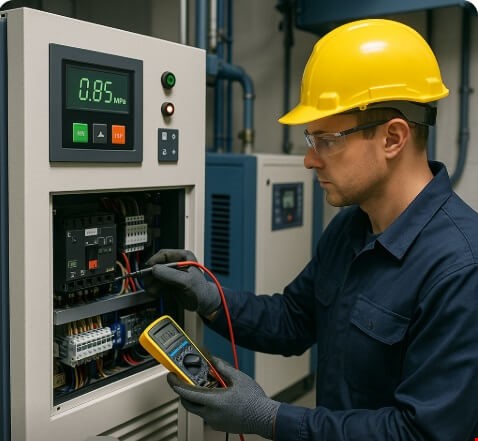There are several key differences between AC induction motors and permanent magnet synchronous motors (PMSM). Permanent magnet motors must operate with a frequency converter (inverter), are more expensive, but have higher efficiency. Induction motors are larger and less efficient compared to permanent magnet motors.
Most pumps and fans used in industrial and commercial applications are currently driven by AC induction motors (ACIM), which stands for "Alternating Current Induction Motor." It is an asynchronous motor that relies on electric current to operate the rotor. The torque is generated by electric current in the rotor, induced by the magnetic field of the stator coils. In ACIM, the rotor always rotates slower than the magnetic field. PMSM, which stands for "Permanent Magnet Synchronous Motor," uses magnets to rotate the rotor, which spins at the same speed as the motor's internal magnetic field.
There are several key differences between AC induction motors and permanent magnet synchronous motors.
Permanent magnet motors must operate with a frequency converter
AC induction motors can be used without a VFD to operate a pump or fan, but they are often installed with a VFD in compressed air or pumping systems to improve system efficiency. A permanent magnet synchronous motor requires a VFD for operation and cannot function without one. A VFD is necessary for the precise control of the PMSM's speed to meet application requirements for pressure, flow, volume, etc. Some new VFDs already come with control options for PMSM as a standard feature, allowing operators to control the PMSM and drive the compressor or pump more efficiently. Permanent magnet motors offer significant efficiency improvements compared to AC induction motors.
The full-load efficiency of a permanent magnet motor is higher than that of an AC induction motor. Figure 1 below shows the efficiency ranges between two standards of AC induction motors and permanent magnet motors.
_20210524105924.867.jpg)
It is important to note that VFDs do not improve motor efficiency. VFDs help improve system efficiency across a range of operating speeds because most systems do not operate at maximum speed all the time. Adding a VFD helps your system's efficiency as it can control the motor's rotation speed, thereby reducing its speed/output.
Adjusting the motor output at the right time saves energy instead of working at unnecessarily high outputs.
Figure 2 compares a 1800 RPM PMSM to an NEMA Premium motor operating with a variable torque load across a 3 to 1 speed range. In both cases, the efficiency of both motor types drops. The efficiency of the NEMA Premium Motor decreases from about 90% to about 72% at 600 RPM, and the ECPM drops from about 94% to 83%. While system operation affects equipment efficiency, it has been proven that permanent magnet motors show higher efficiency compared to AC induction.
_20210524110059.961.jpg)
Advantages of Permanent Magnet Motors
While AC induction motors are more common in motor-driven systems, they are generally larger and less efficient than permanent magnet motor solutions. Although permanent magnet motor solutions tend to be more expensive, they may offer smaller sizes for more compact mechanical packages and, more importantly, higher efficiency.
Permanent magnet motors tend to be more expensive than AC induction motors and are known to be harder to operate than AC induction motors. However, the advantages of permanent magnet motors include higher efficiency (as detailed above), smaller sizes/weights (permanent magnet motors can be up to a third of the size of most AC induction motors, making installation and maintenance much easier), and the ability of a permanent magnet motor to maintain full torque at low speeds. These factors make them more worthwhile in most cases.
The trend is changing
The use of PMSM in conjunction with VFD is not entirely new. However, design engineers and equipment owners are starting to install more permanent magnet motor solutions for ventilation, pumping, and air compression applications, due to their smaller size and higher efficiency. In the past, frequency converters required a special formula to operate a permanent magnet motor, but now many new VFDs are available on the market with a built-in standard feature for controlling permanent magnet motors at no additional cost. As more VFD manufacturers begin to add features for higher performance control of permanent magnet motors, the trend will be for owners and operators to install motor systems that operate more efficiently, in smaller packages, and at lower operational costs.
This might also interest you:

5 Common Industrial Air Compressor Problems & Solutions

Air Compressor Cyclone Water Separators Guide